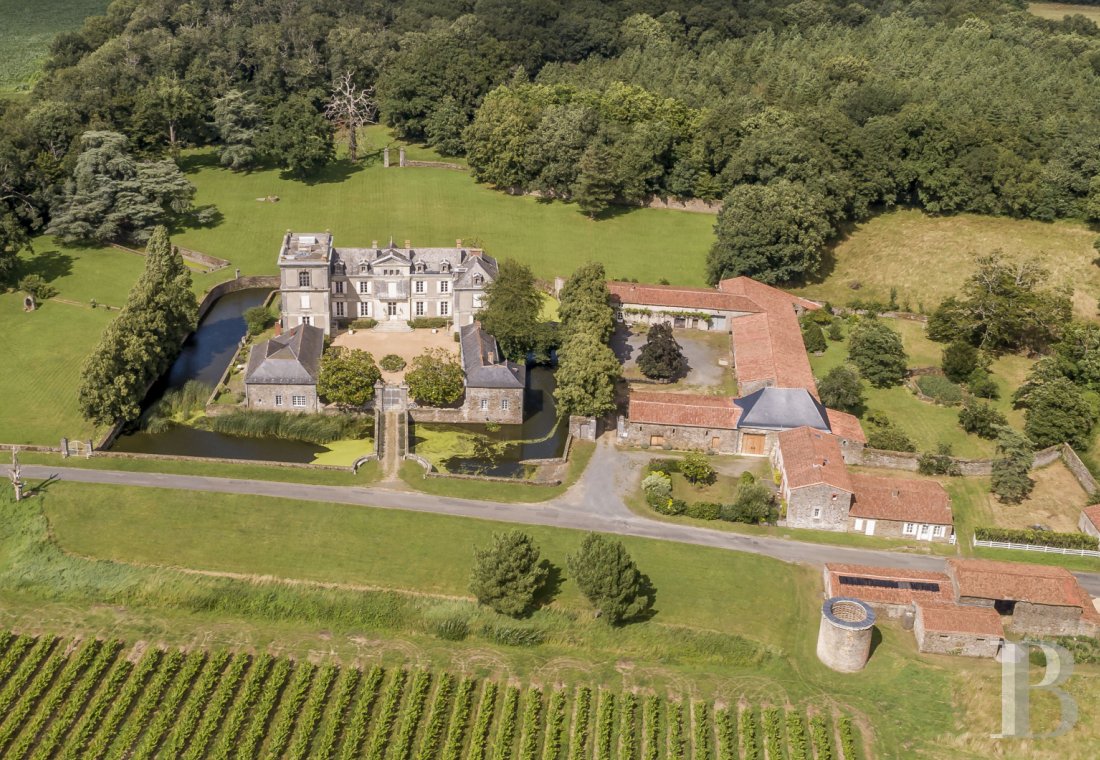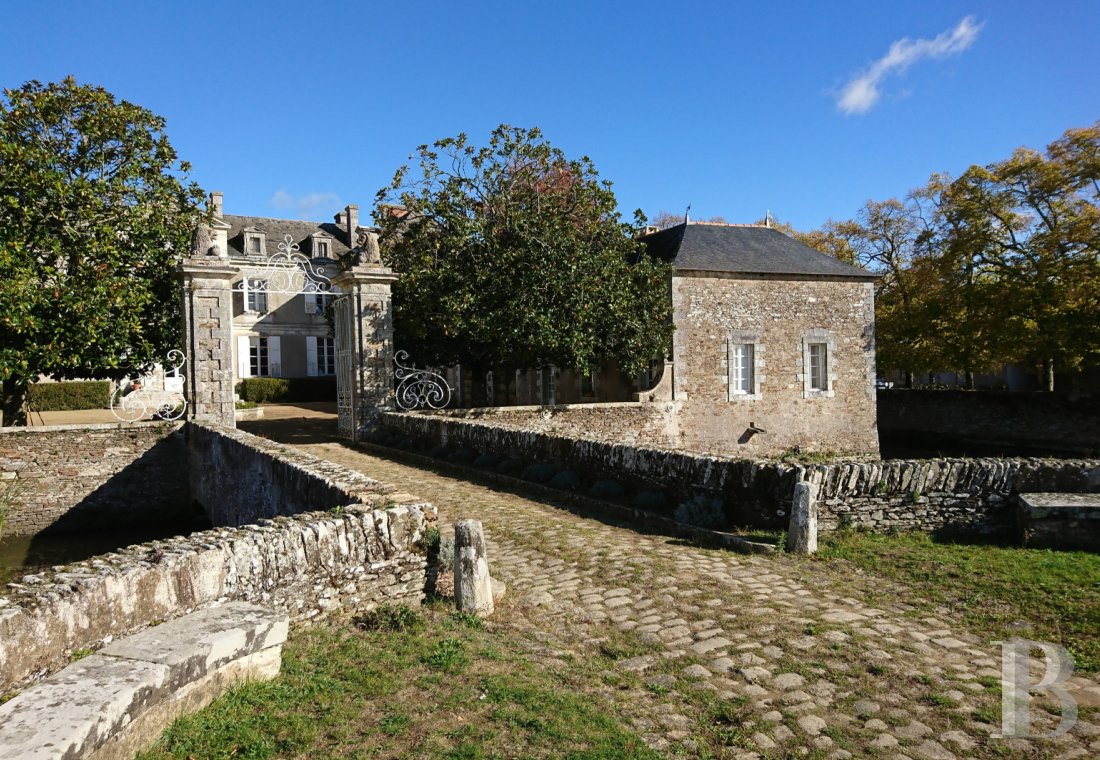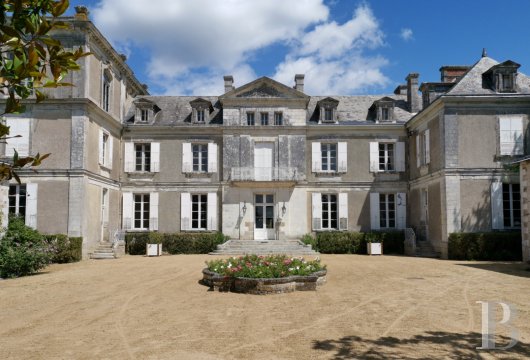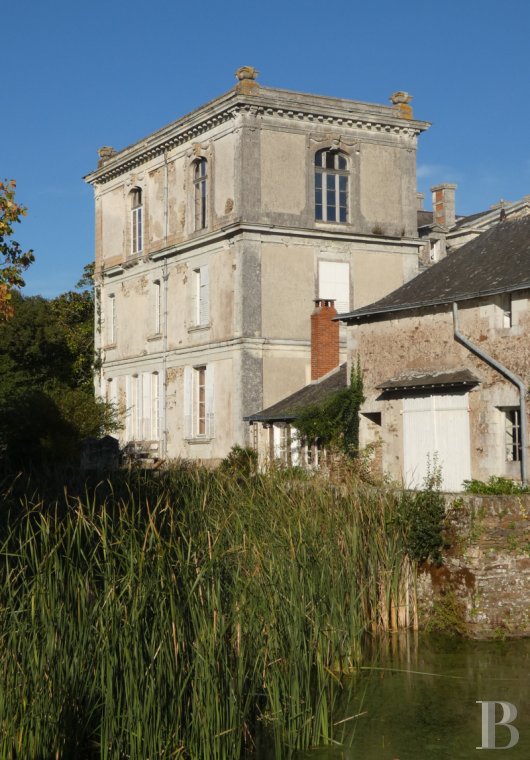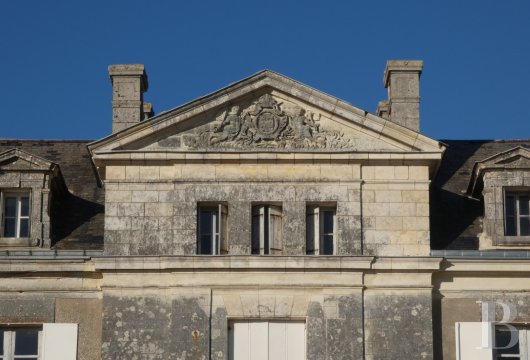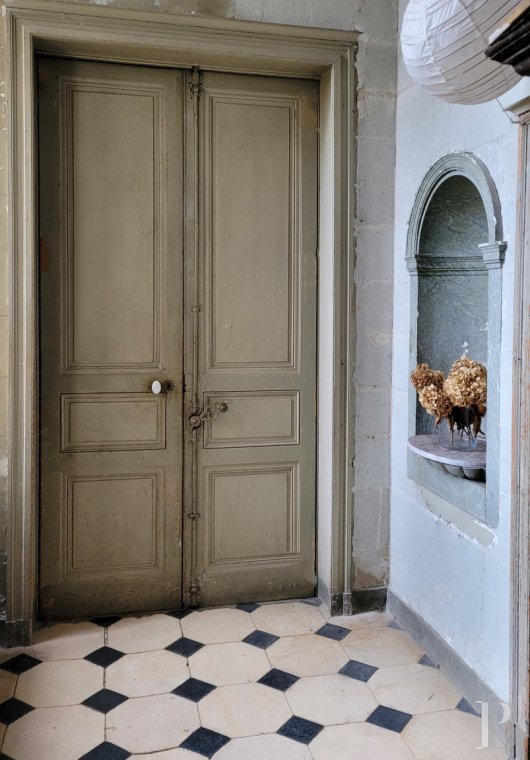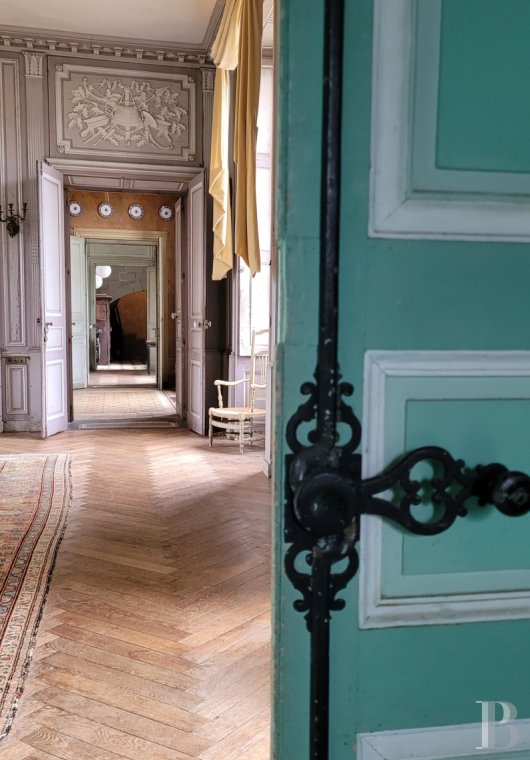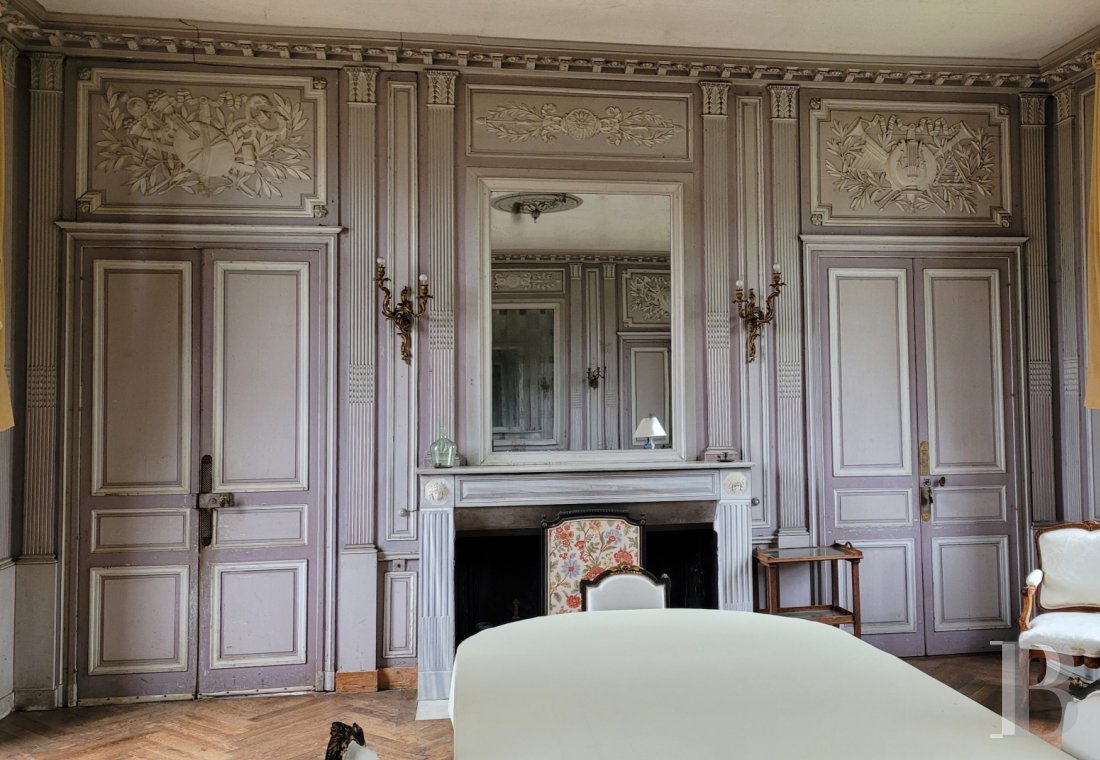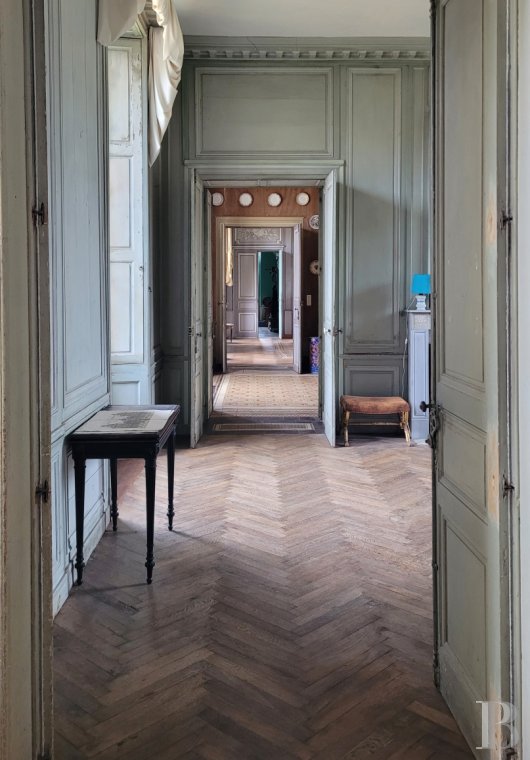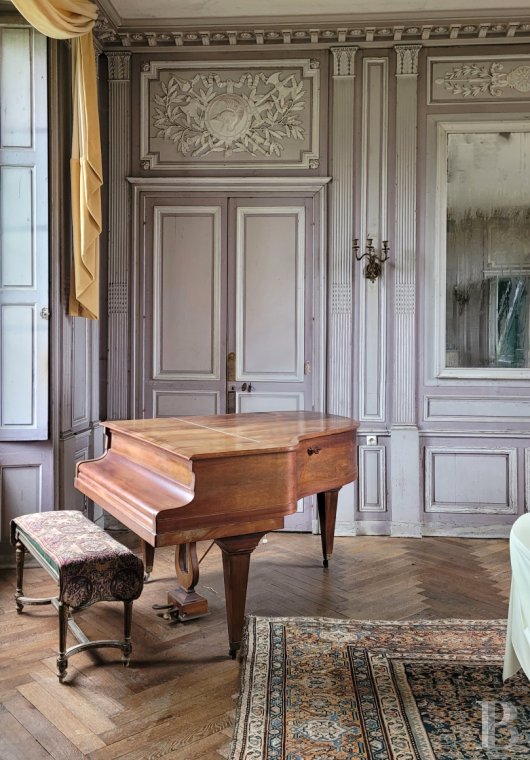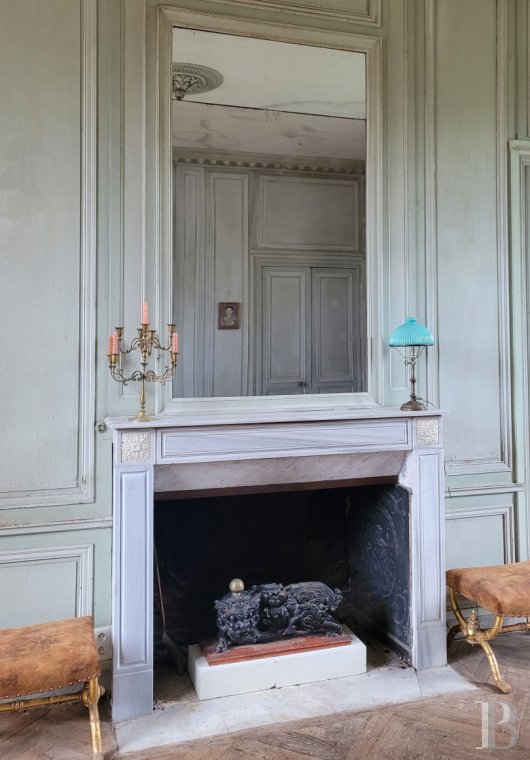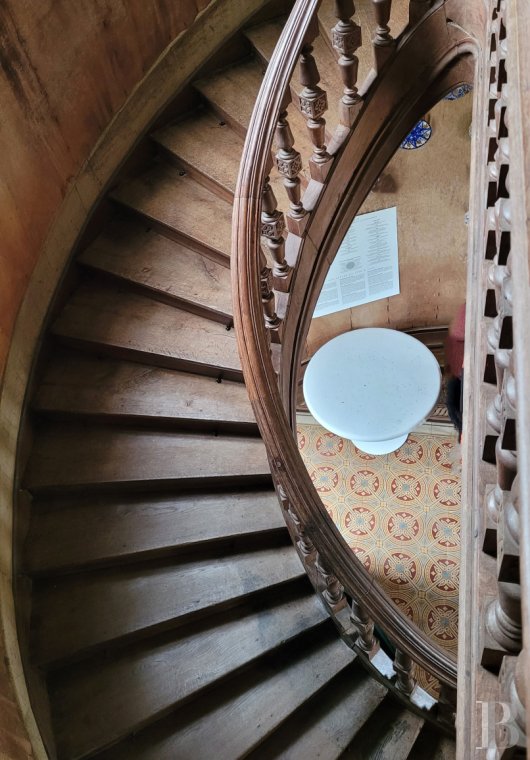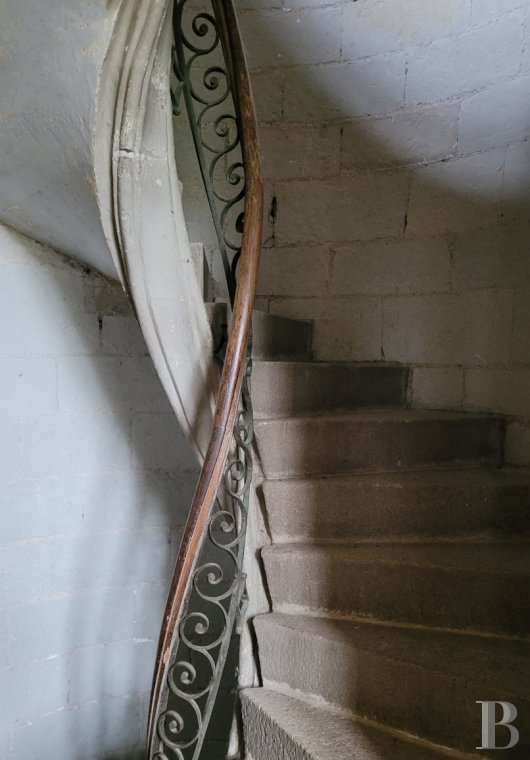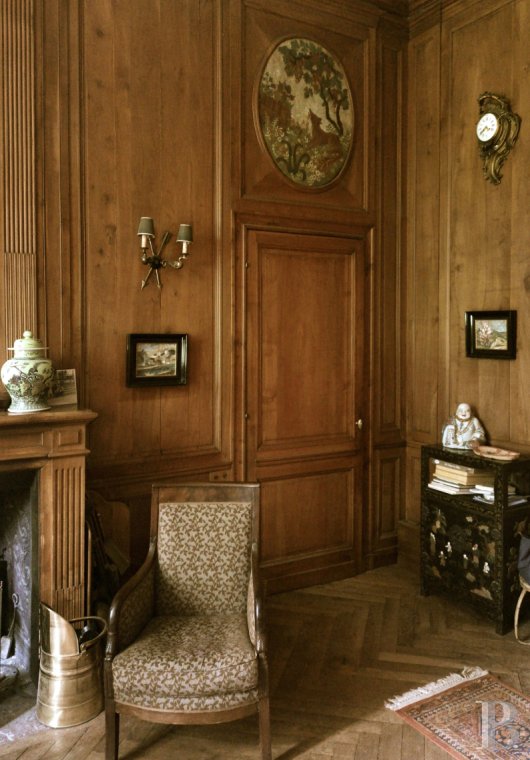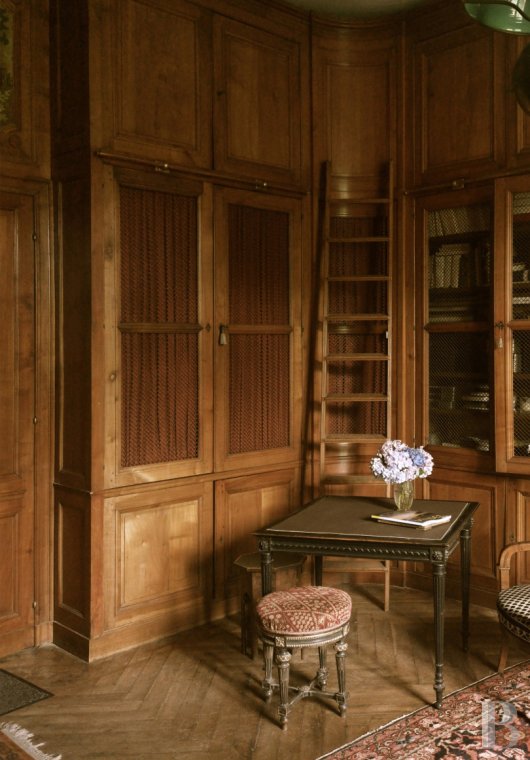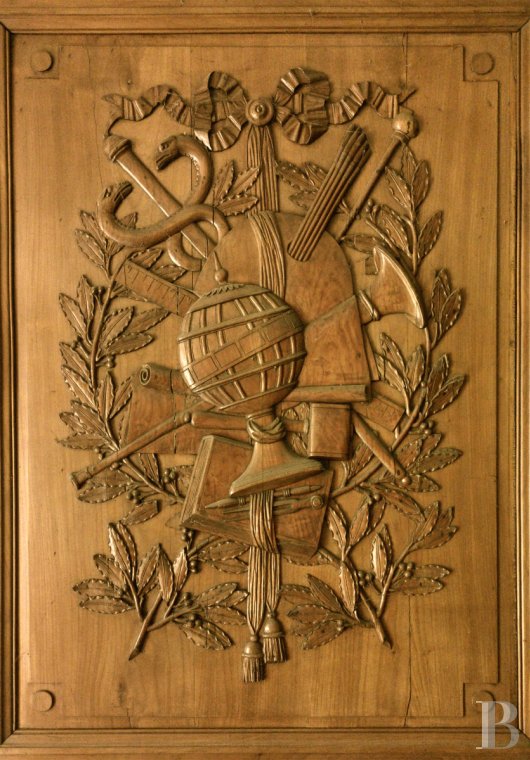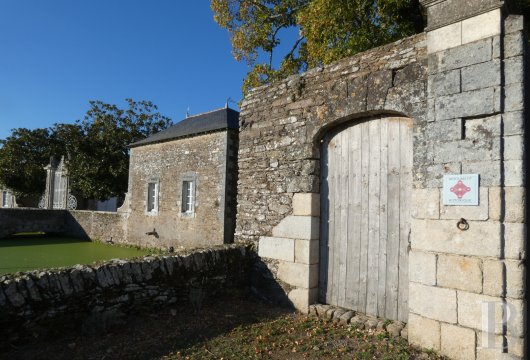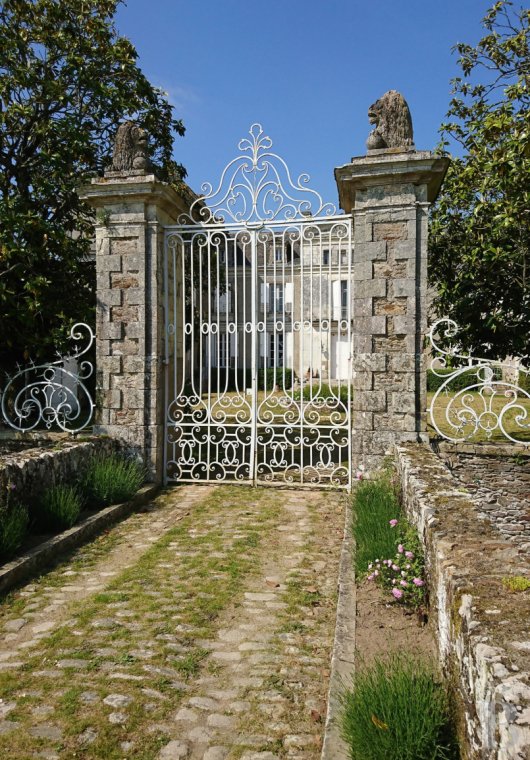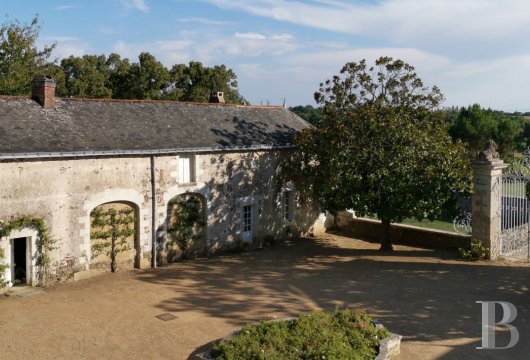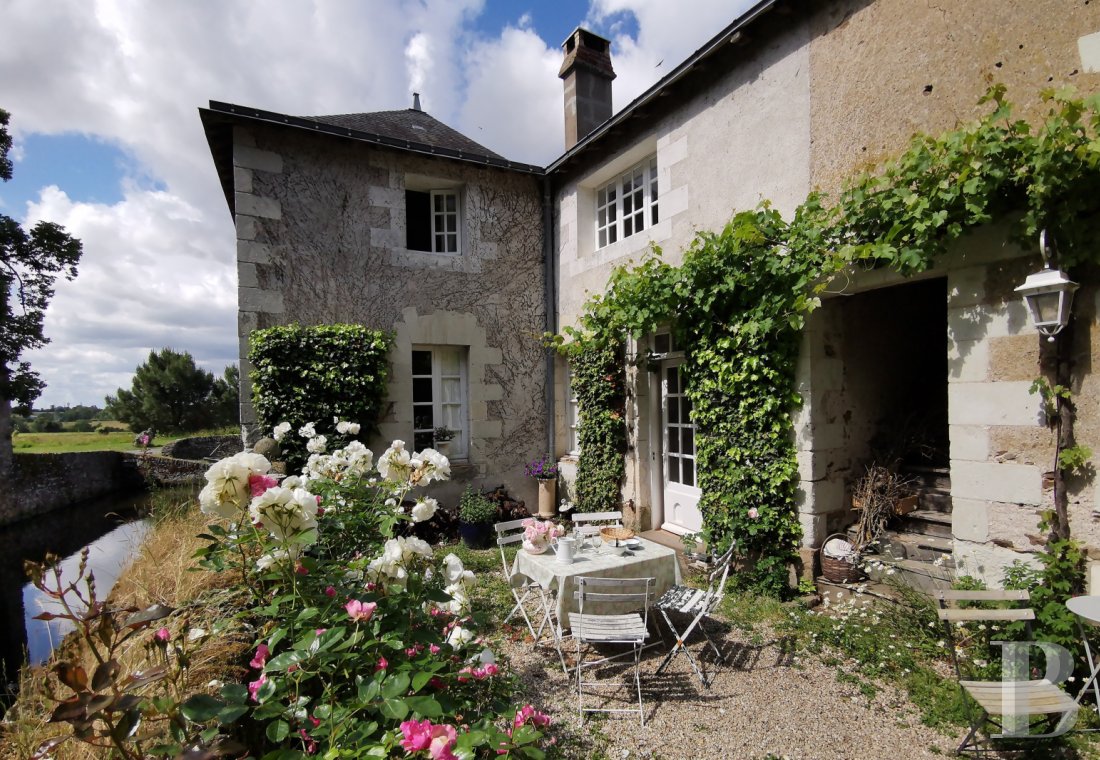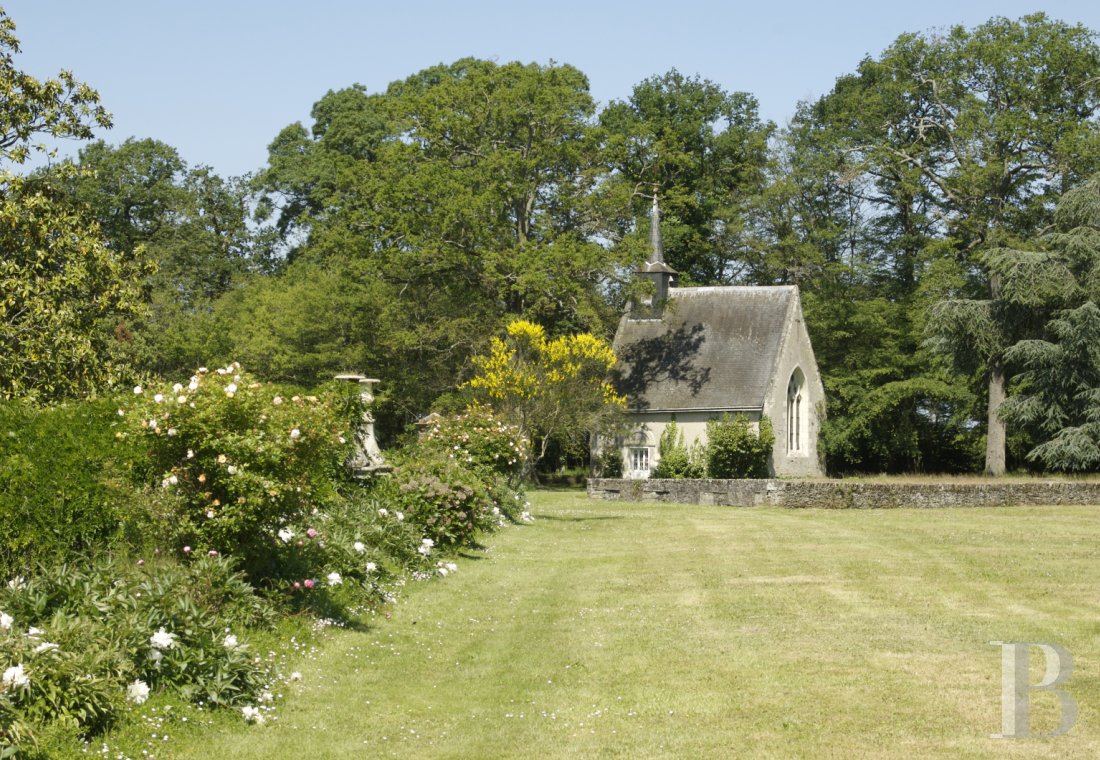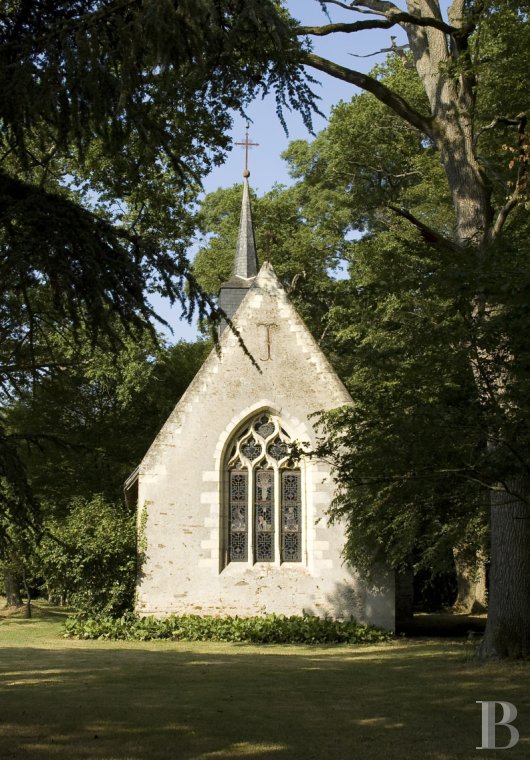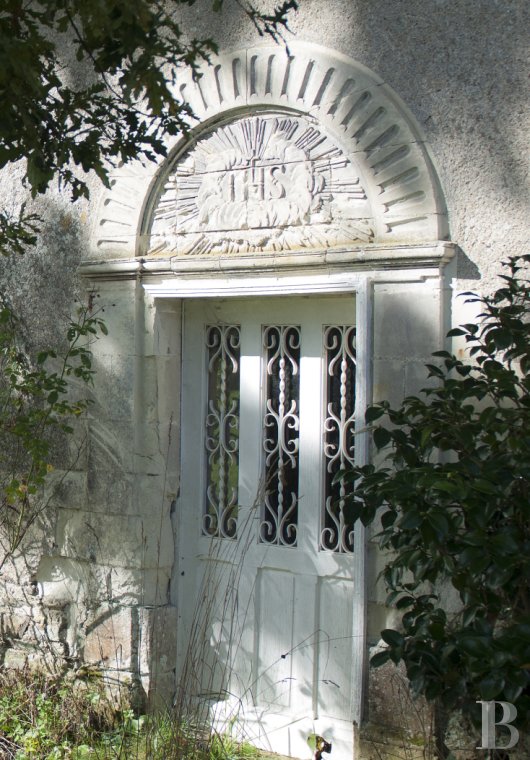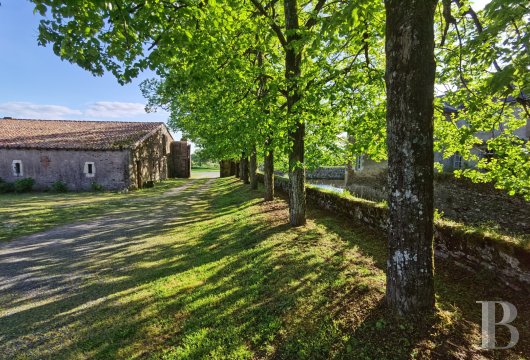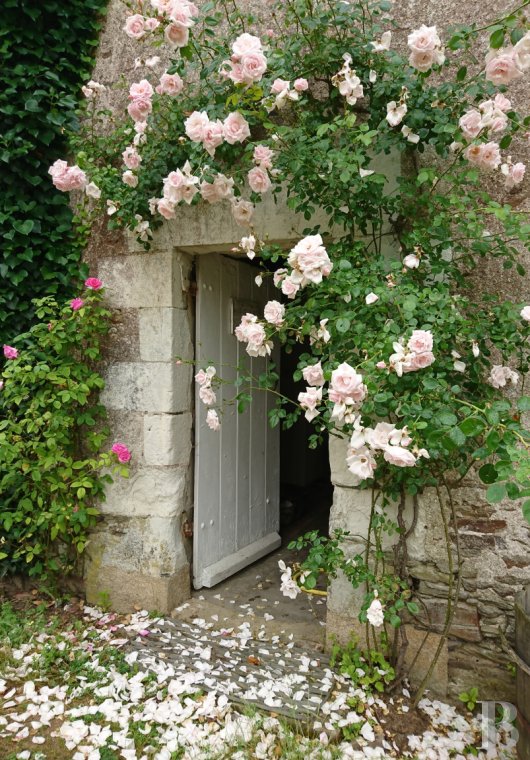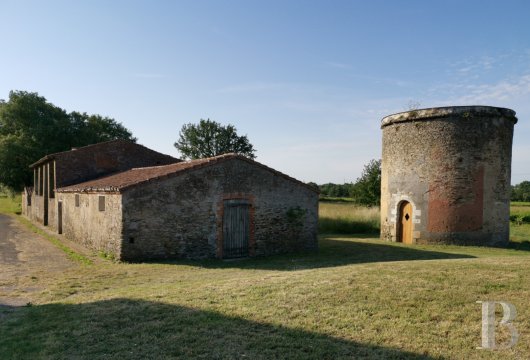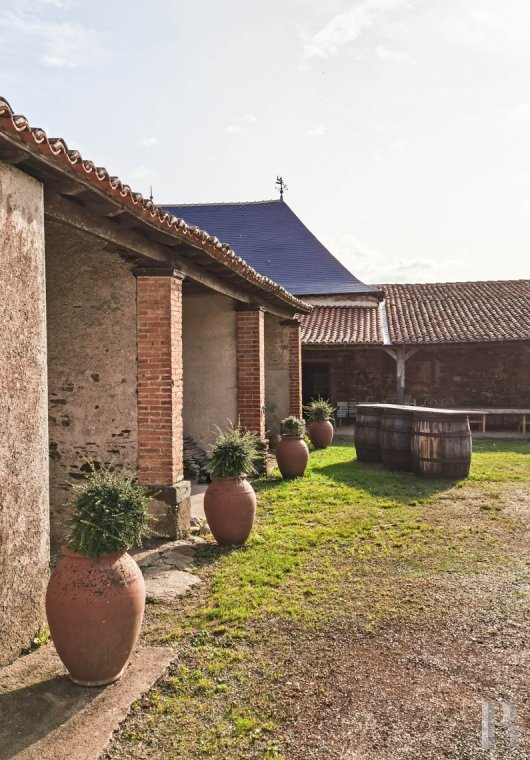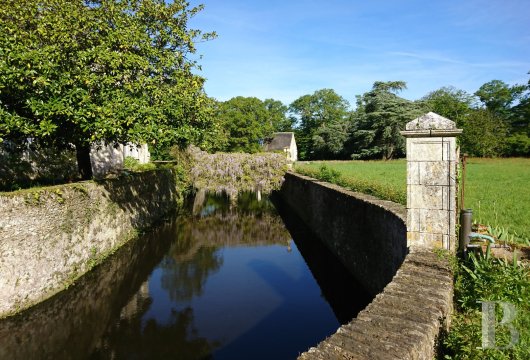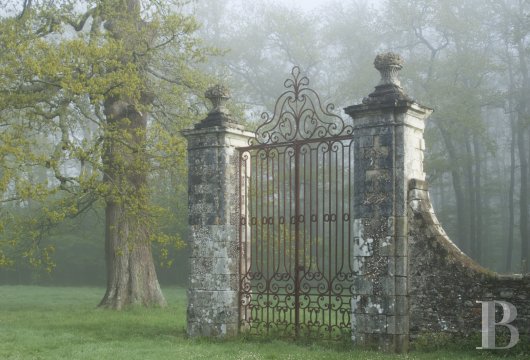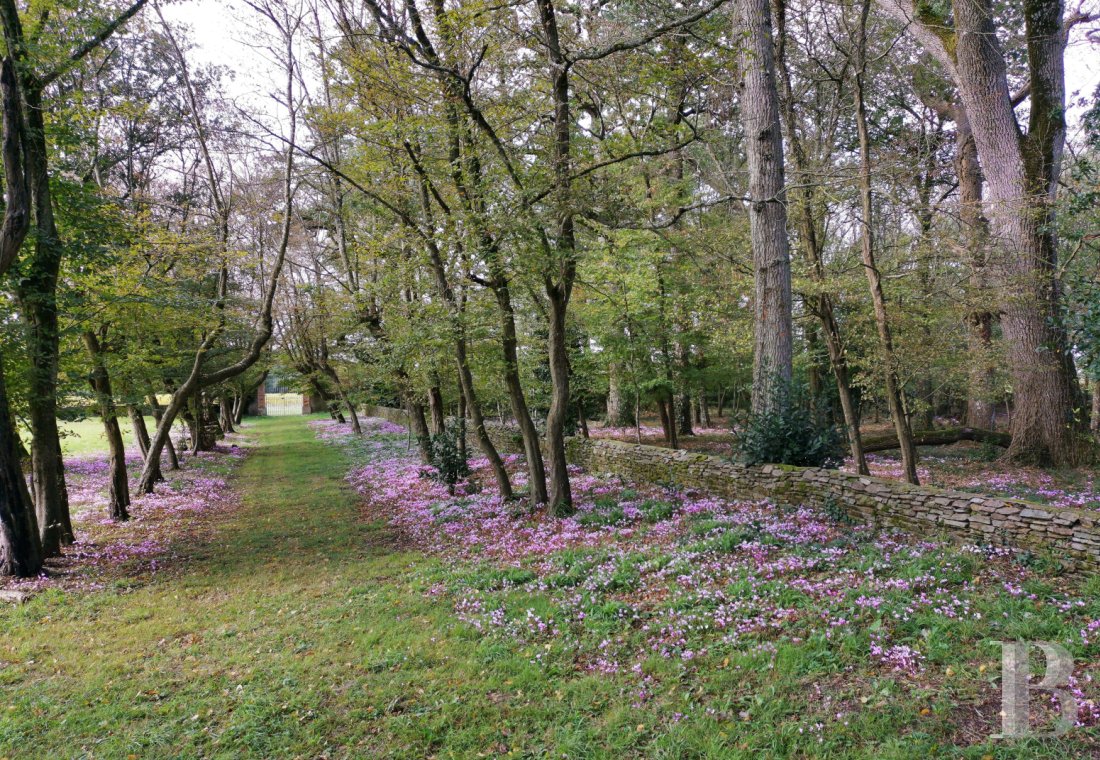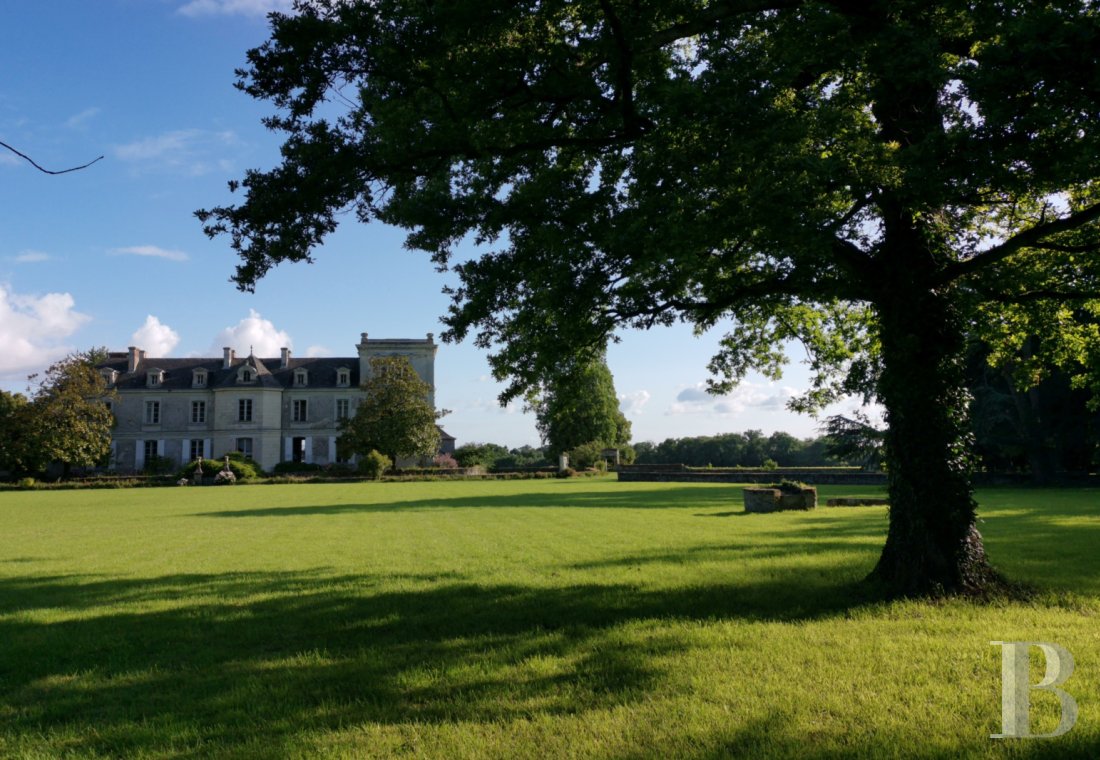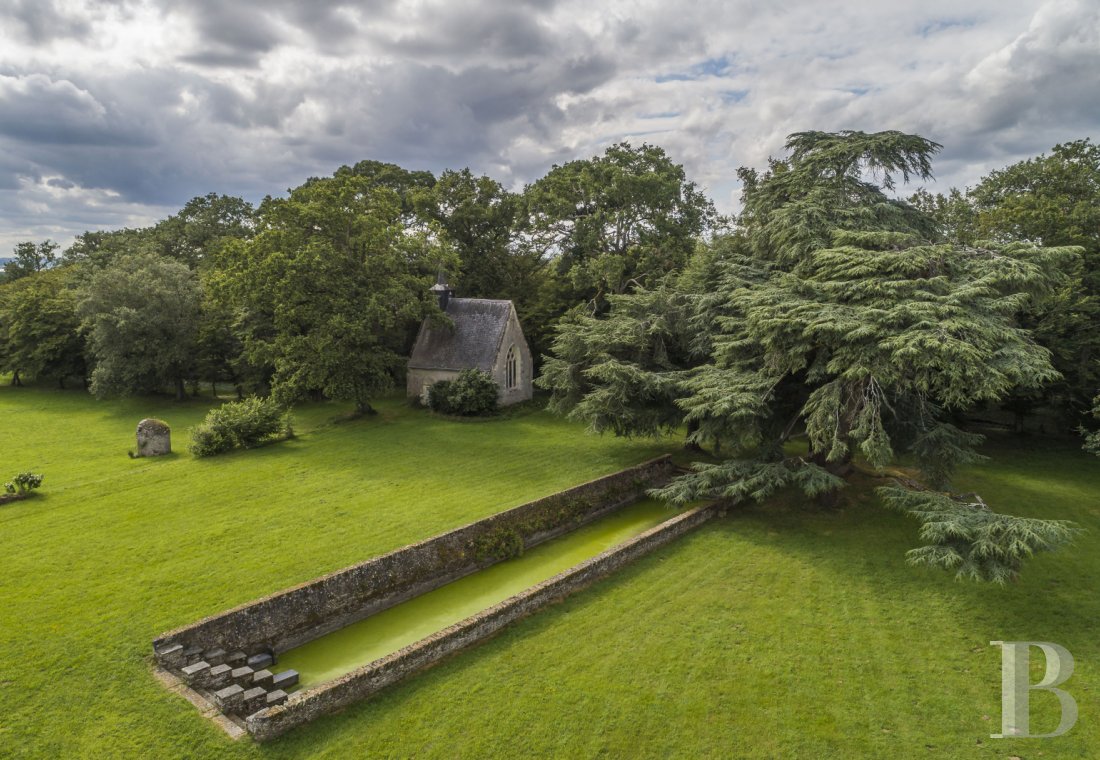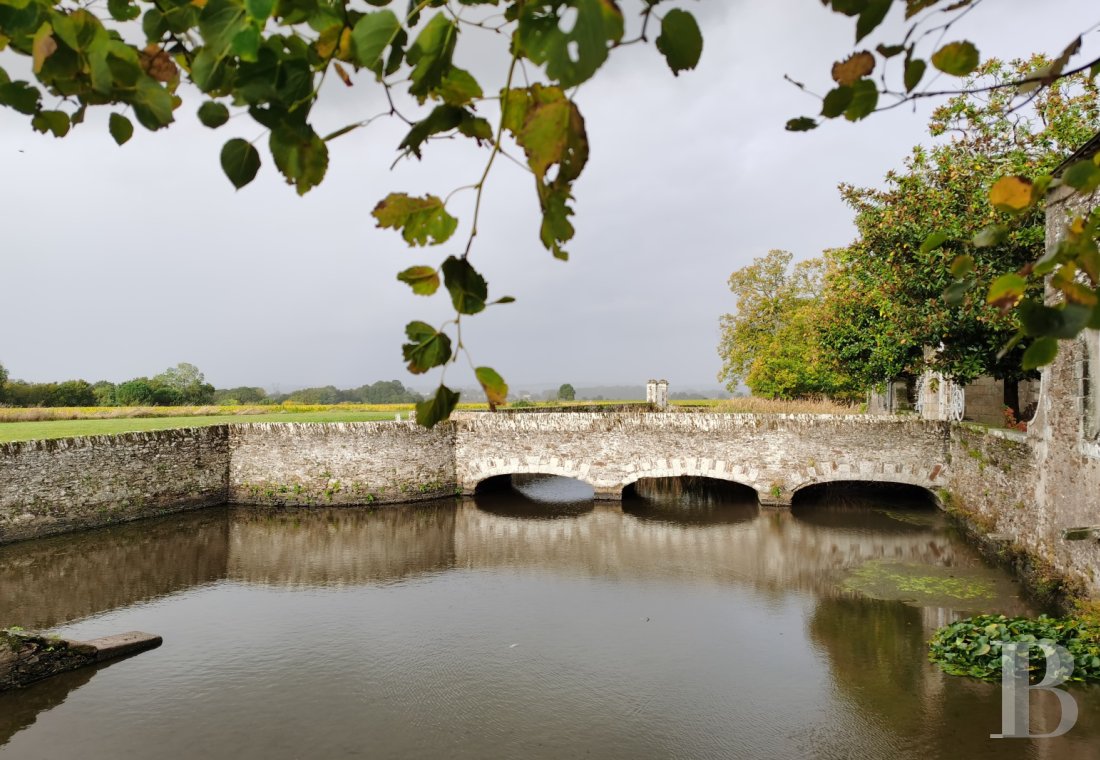Location
The chateau lies in the Nantes vineyards south of the Loire, just a few kilometres from a town with all shops and services, north-east of the City of the Dukes of Brittany, in the Loire-Atlantique department.
Nantes, France's sixth-largest city in terms of the number of inhabitants, its TGV high-speed train station linking to Paris and its international airport are accessed in less than 30 minutes. The nearest beaches on the Atlantic coast are just 1 hour away.
Description
The chateau is protected by a perimeter wall surrounded by water-filled moats and accessed via a semi-circular earth platform and a 16th-century stone bridge from the road, as well as by a wooden footbridge from the winery courtyard or the park to the rear. Completely enclosed by walls, the grounds include a chapel, a fishpond and a hoof bath for horses, as well as an ornamental woodland. Including the vineyard and tenanted farmland surrounding the complex, the property covers almost 73 hectares.
The residence and outbuildings are built on a square earth platform measuring around 50 m x 50 m, overlooking water-filled moats that were once part of a fortified castle built around 1411, on the foundations of a Roman villa. In the 16th century, at the height of the Renaissance, the stronghold was transformed into a noble residence. In 1737, an ancestor of the current inhabitants bought the chateau, planted the vineyards and built the winery, thereby transforming the estate into its present configuration. It was only after the counter-revolutionary Wars of the Vendée, during which the estate repeatedly burnt down, that the dwelling was rebuilt in its current neo-classical style. It was subsequently enlarged at the end of the 19th century, with a central pavilion on the rear facade, and then at the beginning of the 20th century, when the height of a wing was raised to create an artist's studio in the Italian neo-Renaissance style.
In 2011, the facades and some of the rooms in the residence, as well as the chapel, barn, dovecote, wine storehouses, hangar, bakehouse and part of the grounds were listed as French historic monuments.
The dwelling
The dwelling is situated at the back of the courtyard and features two wings set at right angles to each other, one to the east and the other to the west. It is punctuated with five bays. The wings at right angles have two bays. It has three storeys, one of which is in the roofspace, and a slate roof with triangular pediment dormers. It is of coursed schist masonry on a granite foundation. The window surrounds, corner quoins, cornices and dormer windows are all of tuffeau limestone. The central bay of the dwelling is emphasised by an avant-corps, topped by an attic storey with three dormer windows reminiscent of a short colonnade. It is crowned by a large triangular tuffeau limestone pediment, carved with the coat of arms of the original owners, whose descendants still live here today. The avant-corps is preceded by a perron and, on the piano nobile, a central French window opens onto a balcony with a wrought-iron balustrade. On the upper level of the west wing, there is an artist's studio lit by large windows and topped by a roof terrace with a breathtaking view over the Loire Valley. The rear facade of the residence, facing the parklands, features a central five-sided tuffeau pavilion, whose roof is lit by an arched pediment dormer. It houses a large staircase leading from the hallway to the first floor.
With a total floor area of around 1,200 m², the building is single-pile with a corridor, except for the three central rooms on the ground floor, which are full-width. The entire building is in need of complete restoration.
The ground floor
Access is from the main courtyard via the approach steps to the perron and the central glass door, or via the wings at right angles, each of which has its own entrance. In the central section, the hallway leads on one side to a large dining room, followed by a corridor laid with cabochon tiling serving a small dining room with straight strip hardwood flooring, a kitchen, a passageway with a staircase, and finally, housed in the angled section of the west wing, a library with herringbone parquet.
On the other side, the hallway opens onto a large sitting room and a corridor laid with the same cabochon tiles, serving two rooms, one with terracotta tiles, the other featuring parquet flooring with Aremberg pattern. It leads first to a suspended spiral staircase with wrought iron balustrade to the upper floors of the east wing and then to the old kitchen with granite floor tiles, housed in the section set at right angles. Converted into a living room with a large fireplace featuring a straight hood, the old kitchen connects to a scullery at the back of the spiral staircase.
In the central part of the dwelling, the three full-width reception rooms follow on from one another. They have retained their Directoire decor, with geometric and floral cement tiles in the hallway and herringbone parquet flooring in the dining room and grand sitting room. Both rooms feature white marble fireplaces with fluted jambs and ceilings adorned with cornices and central roses. Their walls are clad in high panelling painted parma blue or pale green with a white finish. In the dining room, the wood panels are framed by fluted pilasters and, above the doors, carved bas-reliefs depict music, science and the arts, war and hunting scenes.
The library walls are clad in brown oak panelling that is in an exceptional state of preservation. The wooden overmantel above the fireplace represents a trophy of instruments symbolising the sciences and the arts and, above the doors, oil paintings illustrate La Fontaine’s Fables: "Le Cochet, le Chat et le Souriceau” - (The Cockerel, the Cat and the Mouse), "Le Renard et les Raisons” (The Fox and the Grapes), "Le Héron et le Limaçon” (The Heron and the Snail).
The first floor
This level is accessed from the hallway via the large wooden staircase with balusters installed in the rotunda or via the side staircases of the wings. A long corridor lit by windows overlooks the parklands to the rear and runs the entire length of the residence. It leads to the bedrooms. Five of these are located in the corps de logis, overlooking the main courtyard. The central bedroom, known as the "king's bedroom", extends over the central bay. A French window opens onto a balcony. Another full-width bedroom, known as the “visitor’s” bedroom, connects to the west wing of the dwelling. The west wing contains a large bedroom with its own bathroom, the small staircase and another bedroom facing the park to the rear. At the other end of the corridor, in the east wing, a passageway leads to a bathroom, the spiral staircase and a large bedroom known as the "bridal bedroom", which extends over the entire section at right angles. All the bedrooms have straight strip hardwood floors and some feature fireplaces. There are also three bathrooms with toilets.
The second floor
This storey can only be accessed via the staircases at either end of the main building. On the east side, a single room with two dormer windows takes up the wing at right angles. The terracotta tiles and floor joists follow the pattern of the timber frame. In the main building, a corridor leads to a bathroom and eight bedrooms with sloping ceilings. Five overlook the park, three the main courtyard. The entire storey is lit by dormer windows and has terracotta tiled floors. The bedroom in the central five-sided pavilion is larger than the others and receives light from the dormer window with an arched pediment.
At the end of the corridor, the upper storey of the west wing contains the artist's studio. Illuminated by tall, wide windows and a skylight, it comprises two large rooms with cement floor tiles featuring floral motifs arranged in a chequered pattern. The ceiling height is roughly 6 m. One of the rooms has a narrow staircase leading to the first floor. In the other, a spiral staircase provides access to the terrace extending over the entire roof. Decorated with stone vases adorned with garlands, it offers a panoramic view over the Loire Valley and takes your gaze beyond Nantes.
Base level
Accessed from outdoors only, it stretches across part of the east wing. It includes a wine cellar, a larder and a technical room with a draw pump supplying the dwelling with water.
The outbuildings of the main courtyard
Built along the moats to the east and west of the main courtyard, they are linked to the residence by passageways. With a rectangular layout, they are of coursed schist masonry. The corner quoins and ornamentations are of tuffeau limestone. They are topped by four-pitched slate roofs crowned by zinc weathervanes.
The group of buildings
The outbuilding to the east is a former stable. It houses a tack room, a utility room and a lodging which comprises a living room with hardwood floor and a kitchen on the ground level, and two bedrooms and a bathroom on the first floor. It is rented out furnished under a residential lease.
The western outhouses comprise a workshop, a greenhouse, two garages and a lodging. The flat is currently being restored and comprises a living room with terracotta tile floor, a kitchen, a bedroom with hardwood flooring and a bathroom. It is on the ground level. The living room faces the moat and parkland to the west. This dwelling is also rented out furnished under a residential lease. The attic space of the western outhouses is not converted.
The winery courtyard and outbuildings
Built on the site of the former base-court of the fortified castle to meet the needs of the wine-growing activity, this complex dates back to the 17th century. Almost square in plan, measuring around 35 x 30 m, the courtyard is accessed via the entrance gate on the south side and the wooden footbridge from the chateau to the west. It is bordered on one side by the moat, and on the other by low, uniform buildings set at right angles, which used to contain the winery.
The outbuilding
Built of coursed schist masonry and topped by a gable roof of monk-and-nun tiles, it contains the former winery, no longer in use, a wine attic, an upper cellar and a lower cellar. Two storerooms and a shelter open to the courtyard link the former winery to the barn. A covered passageway provides access to the courtyard with the hoof bath and its enclosed garden.
The barn
Together with the stable, it closes off the winery courtyard on the south side. The coursed schist masonry structure is topped by a four-pitched, hip slate roof. Completed in the mid-17th century by a master carpenter, the roof structure is unique and innovative for its time, light and robust at once. It has undergone a thorough and highly professional restoration over the last few years, with the generous support of a major heritage organisation. The building is frequently used for small private or cultural events.
The house currently rented out
Situated at the entrance to the winery courtyard on the edge of the country lane, this house, together with the adjoining lower house to the rear, which no longer forms part of the property, was once the farmers' accommodation. There is a small garden in front, separated by a hedge.
Built of coursed schist masonry topped by a gable roof clad with monk-and-nun tiles, its windows were modified in the 19th century in the Clisson style, with split brick ornamentations inspired by the Italian rural style. It has two storeys, one of which is in the roofspace and has been converted into a dwelling. The interior comprises a large living room with fireplace, a kitchen and, upstairs, three bedrooms and a bathroom. The house is rented out unfurnished on a residential lease.
The former farmstead and the dovecote
The former rural farm
The buildings of the former farmstead are set back from the chateau on the other side of the country lane: a stable, a cowshed, a straw barn, pigsties and a bakehouse, formerly a common oven, in a particularly well-preserved state.
The dovecote
Situated across from the straw barn, the round coursed schist masonry building dates back to the 17th century. It is covered in a peculiar, probably original rendering, forming wide vertical bands of yellow, red and white fat lime. The door span and the foundation of the building are black. This aviary has 497 split brick nesting holes to house the pigeons. In the 1960s, the dovecote lost its stone dome when a military aircraft flew past at low altitude and supersonic speed.
The chapel
Deconsecrated in the 1960s, it is located in the park, apart from the residence. A wrought iron gate and a pointed tree tunnel lead from the driveway to this small 16th-century building, which was altered in the 17th and 19th centuries. It is of coursed schist masonry on a granite foundation, rectangular in plan and lime-rendered. The corner quoins and ornamentations are of tuffeau limestone. Its saddleback slate roof slopes steeply and is topped by a square bell tower with an octagonal spire. The bottom of the bell tower is clad in slate tiles forming a fish-scale pattern. Its 130 kg bell rings the B flat note. The rectangular chancel has a Gothic window featuring a stained glass triptych depicting a crucifixion, the Virgin Mary, Mary Magdalene and John the Evangelist. Access to the inside is through a large neo-Gothic pointed-arch door topped by a trefoil. The floor is laid with a chequerboard of marble and slate tiles. The pointed arch ceiling is covered with painted panels depicting a sky dotted with stars and fleurs-de-lis. The shrine-shaped altar is of polychrome marble. It is framed by two recesses with 18th-century painted wooden statues: a Virgin and Child and Saint-Roch, the chapel's patron saint, with his dog.
Restoration is now called for.
The parkland and the fishpond
The parkland lies at the back of the chateau, to the west and north of the dwelling. It was designed in the formal French style during the "Grand Siècle” (the reigns of Louis XII and Louis XIV). Centuries-old oaks, hornbeams and cedars now thrive here. A large oblong masonry basin measuring roughly 30 x 5 m is fed by rainwater and used as a fishpond. It is accessed from either end by flights of ten or so steps. Nearby, a small stone turret houses a dome-shaped covered well. Access to the water is protected by a metal gate with key lock.
The hoof bath enclosure
To the east of the winery courtyard and associated buildings, a half-elliptical enclosure with mid-height walls houses a hoof bath for horses. Used for washing horses, this oval pool measuring around 14 x 9 m is surrounded by two symmetrical ramps to make it easier for horses to get in and out of the pool. Restored in 2020 by volunteers under the guidance of an official architect specialising in heritage conservation, the hoof bath has now been restored to its original shape and appearance.
The enclosure also contains old pigsties and a storage annexe.
The grounds
The mixed grove
Once surrounded by a wall, of which only a few dozen metres remain, the park opens onto a wooded area via an iron gate identical to the one in the main courtyard. Its granite pillars, covered in a mosaic of red, white and black gravel, bear fruit baskets carved into the stone. Behind this fence, the woodland extends over almost 12 hectares protected by walls. Mostly comprising sessile oaks and laricio pines, it is covered by a simple management plan covering the period 2020-2035.
The farmlands
Two farmers currently share this land under farm leases totalling just over 35 ha. One farmer raises grass-fed cattle, while the other grows wheat and maize on a rotational basis, using integrated farming methods.
The vineyards
A GAEC (special type of non-trading agricultural company) manages 22 ha of vines located in front of the dwelling to the south, under a rural wine-growing lease. The farmers use integrated farming methods to grow four of the region's grape varieties: Pinot Noir, Floréal, Chardonnay and Sauvignon, which they then sell through a local cooperative.
Our opinion
An outstanding architectural complex, coupled with an agricultural and wine-growing estate, owned by the same family for three centuries. From the Wars of the Vendée to the nights of festivities involving artists and great designers to the adventure of these winegrowers passing on the passion from mother to daughter, each stone here bears witness to the history of an endearing and poetic place.
The task of the future inhabitants will be to carry out the restoration work the chateau requires at the present time. Its listed status should facilitate future work and provide it with the same quiet strength to see it through the next centuries as the age-old cedars standing in its vast grounds.
Reference 439218
| Land registry surface area | 73 ha 63 a 65 ca |
| Main building surface area | 1175 m2 |
| Number of bedrooms | 18 |
| Outbuilding surface area | 1740 m2 |
NB: The above information is not only the result of our visit to the property; it is also based on information provided by the current owner. It is by no means comprehensive or strictly accurate especially where surface areas and construction dates are concerned. We cannot, therefore, be held liable for any misrepresentation.


